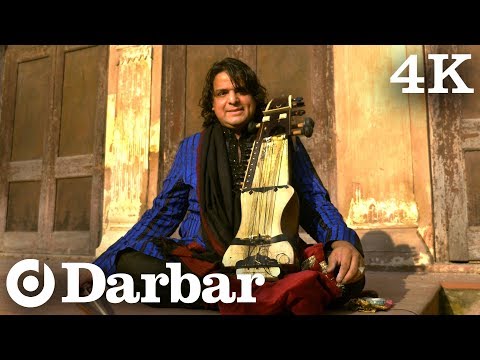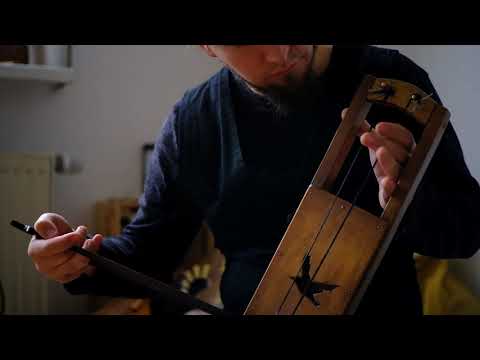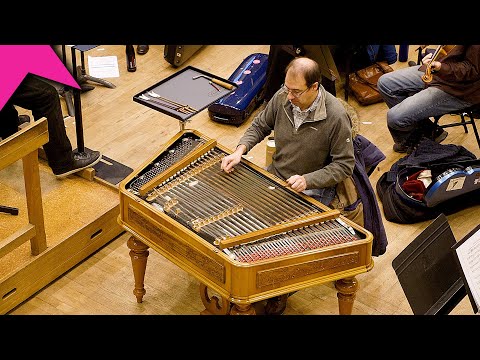Artists are constantly innovating and finding new ways to experiment and bring new sounds to delight our ears. And this has always been the case! But there have been some seriously bizarre instruments used by artists. Some of them you no longer see today (or only in rare cases). These instruments may have gone out of style because of their size, sound, or practicality. There are probably hundreds of other instruments that have been lost to history. Our focus today is on the most bizarre instruments you don’t see today. Let’s get into it!
10 Crwth (Bowed Lyre)
The first instrument on our list is the crwth—also called a bowed lyre, crowd, rote, or crotta—a stringed instrument that is Welsh in origin. It was invented long ago, likely back in the 11th century. A crwth, like a lyre, is a stringed instrument. It is basically a box with a flat fingerboard and six strings of varying thicknesses. Pictures from history show us that a crwth player would hold the lower end against their chest and strap it around their neck. Think of a larger violin with a flat, larger body and more strings. The crwth was one of Wales’s most popular stringed instruments for centuries, along with the harp and timpan. Though modern versions of the crwth have been created, there are thought to be only four surviving original crwths still in existence. They are all housed in museums: St. Fagans National Museum of History in Cardiff, the National Library of Wales in Aberystwyth, the Warrington Museum & Art Gallery, and the Museum of Fine Arts in Boston, USA. Though it was very popular centuries ago, the crwth has slowly been replaced by harps, guitars, violins, and other stringed instruments we use today.
9 Cajón
Next on our list is a percussion instrument called a cajón. A cajón is shaped like a box or drawer with a hole in the back. It is played by slapping or hitting the front or back plate of the box shape. On some occasions, mallets or drumsticks are used instead of hands. Watch this video on YouTube The cajón originated in Peru in the early 19th century. There are two theories as to how it was invented. Some think the cajón was adapted from other African box percussion instruments and brought over by slaves. Another theory is that slaves were forced to carry fruits and other goods in boxes, and when they got a moment to rest, they would play music on the boxes, eventually leading to the design of the cajón. Either way, cajóns are popular in Peruvian music, particularly Afro-Peruvian music. Because of their unique sound, cajóns are sometimes used in flamenco and jazz music today, though very rarely.
8 Sambuca (Hurdy-Gurdy)
A sambuca (or hurdy-gurdy) was another stringed instrument from the ancient past. It was originally invented in ancient Greece. A sambuca was a small harp with a triangular shape and a very shrill tone. There are many origin stories about the sambuca, and it is hard to tell which is the truth. The various claims include:
Eusebius credited the Troglodytae (cave-goers) with inventing the sambuca. Athenaeus claimed that the inventor of the sambuca was named Sambyx and named it after himself. Polybius compared it to a rope ladder, while other scholars said it was shaped like a boat.
Because the sambuca is from such a long time ago, it is hard to tell fact from fiction. Fascinatingly, sambuca is used not only as a name for this instrument but also to describe a hand-cranked string instrument from the Middle Ages and a woodwind instrument created from a Sambucus tree. One thing is for sure, the sambuca (or hurdy-gurdy) is one of the most mysterious and bizarre instruments of all time.
7 Nyckelharpa
Nyckelharpa is a Swedish word that translates to “key harp.” As you might have guessed, this instrument was invented in Sweden. It is an ancient instrument and can be traced to the fourteenth century. The nyckelharpa was a stringed instrument that appeared similar to a fiddle or violin. However, it is quite different. It combines keys and strings to make a very complex instrument. While it is not completely clear how many strings this ancient instrument originally had, it has evolved, and modern versions have as many as 16 strings, along with 37 keys. A nyckelharpa is held similarly to a violin, using a strap around the neck, while the right arm holds the instrument in place. While the original nyckelharpa design has been lost to time, it has changed and grown over time and is the national musical instrument of Sweden today.
6 Sarangi
The next instrument on our list comes to us from the continent of Asia, specifically India. The sarangi is unique not only for its design but also for its sound. When played, it has a wide range of sounds and has been described as sounding like a cat or a person singing. The sarangi is a rectangular wooden box instrument with three strings. It can be played with a bow (like a violin) or plucked (like a guitar). Another thing that makes the sarangi unique is its three sound chambers carved into its body. The sound chambers are covered with animal skin, usually goat skin. These chambers add resonance and a unique, bizarre, even creepy quality. A sarangi is held and played like a cello, though it is much smaller, so players let the instrument rest on their knees. This bizarre instrument was invented in 1865 and is rarely seen outside India today.
5 Erhu
The next instrument on our list comes to us from one of the oldest cultures in the world, China. The erhu dates back more than three thousand years. It is a very small instrument with a fairly simple, though bizarre, design. It is made with a very thin stick neck and a small wooden resonance chamber covered in python skin. Strung to the neck are two strings (traditionally made of silk) held in place by two pegs at the top. The pegs are used to tune the strings for the desired sound. An erhu also has a bow built in. The bow is a wooden or bamboo stick strung with horse tail hair. The horse hair side of the bow is connected to the erhu, so a musician simply moves the bow back and forth to create the desired sound while pressing and releasing the silk strings at the top. It has a bizarre and unique sound you can hear in the video linked above.
4 Gue
The next instrument on our list has nearly been completely lost to history. It is called the gue and was invented in Scotland, specifically in the Shetland Islands. We do not know some things about the gue, but it is clear that it was an instrument with two strings that was somewhat like a violin or lyre. It was played more like a cello than a violin, however. The last known account of a gue is from the early 19th century by Arthur Edmondston in his book View of the Ancient and Present State of the Zetland Islands. There have been recreations of the gue, but with so little information about its origins, it is hard to separate fact from guesswork.
3 Lituus
A Lituus is one of the few instruments on our list that was not necessarily created for enjoyment. Instead, it was for intimidation and communication on the battlefield. That’s right; the lituus was originally created as a war horn. Watch this video on YouTube The distinguishing characteristic of a lituus is its huge size. However big you might think it is, think bigger. This war horn was apparently 8 to 10 feet (2.4 to 3 meters) in length, which begs the question, how can you even hold it up? The lituus was used in a composition created by Johann Sebastian Bach and not much else since then. Scientists have recreated it, but the true design of the lituus has been lost as its popularity waned. Probably due to the enormous size.
2 Duduk
The duduk dates back to the fifth century and maybe even farther back. It was invented in Armenia, though variations exist (or existed) throughout the Middle East and Caucasus regions. A duduk is a double-reed instrument; the earliest versions of the instrument were often made of bone, though more modern versions are made with apricot wood. A duduk has a larger reed than many other double reed instruments (think of the oboe or bassoon). It also has quite a different sound, more like a mournful horn than an oboe. One thing that makes this instrument especially bizarre is that they are almost always played in pairs. One musician plays the melody, while another plays a steady beat, called a “dum.” Though duduks are rarely seen nowadays, they are an important part of Armenian cultural history.
1 Cimbalom
The cimbalom is one of the oldest (and most bizarre) instruments to make the list. It was invented in Hungary in the Middle Ages. The cimbalom also has the most strings of any of the instruments on our list, with as many as 125. The strings are sectioned into groups of three, four, or five strings. Each section of strings is designed to create a unique pitch. Watch this video on YouTube This ancient instrument was not played by hand but instead with the use of soft mallets. A musician can play the cimbalom by striking the strings with soft mallets. The instrument also uses bridges to separate the strings and create more playable pitches. For such an old instrument, it is not only bizarre but seriously complex! Another unique quality of the cimbalom is that its strings are not made with horsehair or silk but metal. The instrument sits horizontally, like a piano, and was the precursor to many other dulcimer instruments.

























title: “Top 10 Bizarre Musical Instruments You Rarely See Today” ShowToc: true date: “2022-12-17” author: “Kristen Browning”
Artists are constantly innovating and finding new ways to experiment and bring new sounds to delight our ears. And this has always been the case! But there have been some seriously bizarre instruments used by artists. Some of them you no longer see today (or only in rare cases). These instruments may have gone out of style because of their size, sound, or practicality. There are probably hundreds of other instruments that have been lost to history. Our focus today is on the most bizarre instruments you don’t see today. Let’s get into it!
10 Crwth (Bowed Lyre)
The first instrument on our list is the crwth—also called a bowed lyre, crowd, rote, or crotta—a stringed instrument that is Welsh in origin. It was invented long ago, likely back in the 11th century. A crwth, like a lyre, is a stringed instrument. It is basically a box with a flat fingerboard and six strings of varying thicknesses. Pictures from history show us that a crwth player would hold the lower end against their chest and strap it around their neck. Think of a larger violin with a flat, larger body and more strings. The crwth was one of Wales’s most popular stringed instruments for centuries, along with the harp and timpan. Though modern versions of the crwth have been created, there are thought to be only four surviving original crwths still in existence. They are all housed in museums: St. Fagans National Museum of History in Cardiff, the National Library of Wales in Aberystwyth, the Warrington Museum & Art Gallery, and the Museum of Fine Arts in Boston, USA. Though it was very popular centuries ago, the crwth has slowly been replaced by harps, guitars, violins, and other stringed instruments we use today.
9 Cajón
Next on our list is a percussion instrument called a cajón. A cajón is shaped like a box or drawer with a hole in the back. It is played by slapping or hitting the front or back plate of the box shape. On some occasions, mallets or drumsticks are used instead of hands. Watch this video on YouTube The cajón originated in Peru in the early 19th century. There are two theories as to how it was invented. Some think the cajón was adapted from other African box percussion instruments and brought over by slaves. Another theory is that slaves were forced to carry fruits and other goods in boxes, and when they got a moment to rest, they would play music on the boxes, eventually leading to the design of the cajón. Either way, cajóns are popular in Peruvian music, particularly Afro-Peruvian music. Because of their unique sound, cajóns are sometimes used in flamenco and jazz music today, though very rarely.
8 Sambuca (Hurdy-Gurdy)
A sambuca (or hurdy-gurdy) was another stringed instrument from the ancient past. It was originally invented in ancient Greece. A sambuca was a small harp with a triangular shape and a very shrill tone. There are many origin stories about the sambuca, and it is hard to tell which is the truth. The various claims include:
Eusebius credited the Troglodytae (cave-goers) with inventing the sambuca. Athenaeus claimed that the inventor of the sambuca was named Sambyx and named it after himself. Polybius compared it to a rope ladder, while other scholars said it was shaped like a boat.
Because the sambuca is from such a long time ago, it is hard to tell fact from fiction. Fascinatingly, sambuca is used not only as a name for this instrument but also to describe a hand-cranked string instrument from the Middle Ages and a woodwind instrument created from a Sambucus tree. One thing is for sure, the sambuca (or hurdy-gurdy) is one of the most mysterious and bizarre instruments of all time.
7 Nyckelharpa
Nyckelharpa is a Swedish word that translates to “key harp.” As you might have guessed, this instrument was invented in Sweden. It is an ancient instrument and can be traced to the fourteenth century. The nyckelharpa was a stringed instrument that appeared similar to a fiddle or violin. However, it is quite different. It combines keys and strings to make a very complex instrument. While it is not completely clear how many strings this ancient instrument originally had, it has evolved, and modern versions have as many as 16 strings, along with 37 keys. A nyckelharpa is held similarly to a violin, using a strap around the neck, while the right arm holds the instrument in place. While the original nyckelharpa design has been lost to time, it has changed and grown over time and is the national musical instrument of Sweden today.
6 Sarangi
The next instrument on our list comes to us from the continent of Asia, specifically India. The sarangi is unique not only for its design but also for its sound. When played, it has a wide range of sounds and has been described as sounding like a cat or a person singing. The sarangi is a rectangular wooden box instrument with three strings. It can be played with a bow (like a violin) or plucked (like a guitar). Another thing that makes the sarangi unique is its three sound chambers carved into its body. The sound chambers are covered with animal skin, usually goat skin. These chambers add resonance and a unique, bizarre, even creepy quality. A sarangi is held and played like a cello, though it is much smaller, so players let the instrument rest on their knees. This bizarre instrument was invented in 1865 and is rarely seen outside India today.
5 Erhu
The next instrument on our list comes to us from one of the oldest cultures in the world, China. The erhu dates back more than three thousand years. It is a very small instrument with a fairly simple, though bizarre, design. It is made with a very thin stick neck and a small wooden resonance chamber covered in python skin. Strung to the neck are two strings (traditionally made of silk) held in place by two pegs at the top. The pegs are used to tune the strings for the desired sound. An erhu also has a bow built in. The bow is a wooden or bamboo stick strung with horse tail hair. The horse hair side of the bow is connected to the erhu, so a musician simply moves the bow back and forth to create the desired sound while pressing and releasing the silk strings at the top. It has a bizarre and unique sound you can hear in the video linked above.
4 Gue
The next instrument on our list has nearly been completely lost to history. It is called the gue and was invented in Scotland, specifically in the Shetland Islands. We do not know some things about the gue, but it is clear that it was an instrument with two strings that was somewhat like a violin or lyre. It was played more like a cello than a violin, however. The last known account of a gue is from the early 19th century by Arthur Edmondston in his book View of the Ancient and Present State of the Zetland Islands. There have been recreations of the gue, but with so little information about its origins, it is hard to separate fact from guesswork.
3 Lituus
A Lituus is one of the few instruments on our list that was not necessarily created for enjoyment. Instead, it was for intimidation and communication on the battlefield. That’s right; the lituus was originally created as a war horn. Watch this video on YouTube The distinguishing characteristic of a lituus is its huge size. However big you might think it is, think bigger. This war horn was apparently 8 to 10 feet (2.4 to 3 meters) in length, which begs the question, how can you even hold it up? The lituus was used in a composition created by Johann Sebastian Bach and not much else since then. Scientists have recreated it, but the true design of the lituus has been lost as its popularity waned. Probably due to the enormous size.
2 Duduk
The duduk dates back to the fifth century and maybe even farther back. It was invented in Armenia, though variations exist (or existed) throughout the Middle East and Caucasus regions. A duduk is a double-reed instrument; the earliest versions of the instrument were often made of bone, though more modern versions are made with apricot wood. A duduk has a larger reed than many other double reed instruments (think of the oboe or bassoon). It also has quite a different sound, more like a mournful horn than an oboe. One thing that makes this instrument especially bizarre is that they are almost always played in pairs. One musician plays the melody, while another plays a steady beat, called a “dum.” Though duduks are rarely seen nowadays, they are an important part of Armenian cultural history.
1 Cimbalom
The cimbalom is one of the oldest (and most bizarre) instruments to make the list. It was invented in Hungary in the Middle Ages. The cimbalom also has the most strings of any of the instruments on our list, with as many as 125. The strings are sectioned into groups of three, four, or five strings. Each section of strings is designed to create a unique pitch. Watch this video on YouTube This ancient instrument was not played by hand but instead with the use of soft mallets. A musician can play the cimbalom by striking the strings with soft mallets. The instrument also uses bridges to separate the strings and create more playable pitches. For such an old instrument, it is not only bizarre but seriously complex! Another unique quality of the cimbalom is that its strings are not made with horsehair or silk but metal. The instrument sits horizontally, like a piano, and was the precursor to many other dulcimer instruments.
























